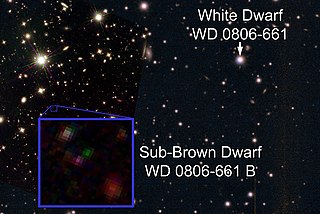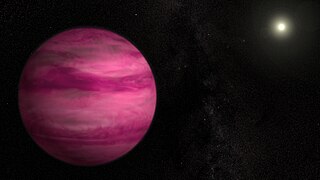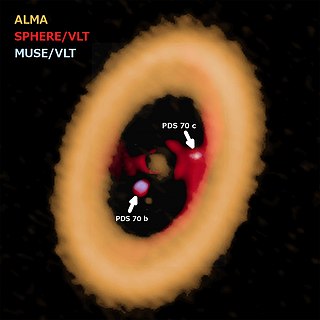Related Research Articles

70 Virginis is a binary star located 59 light years from the Sun in the equatorial constellation of Virgo, near the northern constellation border with Coma Berenices. 70 Virginis is its Flamsteed designation. The star is visible to the naked eye as a faint, yellow-hued point of light with an apparent visual magnitude of +4.97. It is drifting further away with a heliocentric radial velocity of +4.4 km/s and has a high proper motion, traversing the celestial sphere at the rate of 0.621 arc seconds per annum.

Brown dwarfs are substellar objects that have more mass than the biggest gas giant planets, but less than the least massive main-sequence stars. Their mass is approximately 13 to 80 times that of Jupiter (MJ) -- not big enough to sustain nuclear fusion of ordinary hydrogen (1H) into helium in their cores, but massive enough to emit some light and heat from the fusion of deuterium (2H). The most massive ones can burn lithium (7Li).

A rogueplanet, also termed a free-floating planet (FFP) or an isolated planetary-mass object (iPMO), is an interstellar object of planetary mass which is not gravitationally bound to any star or brown dwarf.
Eta Telescopii is a white-hued star in the southern constellation of Telescopium. This is an A-type main sequence star with an apparent visual magnitude of +5.03. It is approximately 158 light years from Earth and is a member of the Beta Pictoris Moving Group of stars that share a common motion through space. It is moving through the Galaxy at a speed of 23.7 km/s relative to the Sun.
HD 38529 is a binary star approximately 138 light-years away in the constellation of Orion.
The Milky Way has several smaller galaxies gravitationally bound to it, as part of the Milky Way subgroup, which is part of the local galaxy cluster, the Local Group.

A sub-brown dwarf or planetary-mass brown dwarf is an astronomical object that formed in the same manner as stars and brown dwarfs but that has a planetary mass, therefore by definition below the limiting mass for thermonuclear fusion of deuterium . Some researchers call them rogue planets whereas others call them planetary-mass brown dwarfs. They are sometimes categorized as Y spectral class brown dwarfs.

NGC 2547 is a southern open cluster in Vela, discovered by Nicolas Louis de Lacaille in 1751 from South Africa. The star cluster is young with an age of 20-30 million years.

HD 15115 is a single star in the equatorial constellation of Cetus. It is readily visible in binoculars or a small telescope, but is considered too dim to be seen with the naked eye at an apparent visual magnitude of 6.76. The distance to this object is 160 light years based on parallax, and it is slowly drifting further away at the rate of about 1 km/s. It has been proposed as a member of the Beta Pictoris moving group or the Tucana-Horologium association of co-moving stars; there is some ambiguity as to its true membership.

Strategic Explorations of Exoplanets and Disks with Subaru (SEEDS) is a multi-year survey that used the Subaru Telescope on Mauna Kea, Hawaii in an effort to directly image extrasolar planets and protoplanetary/debris disks around hundreds of nearby stars. SEEDS is a Japanese-led international project. It consists of some 120 researchers from a number of institutions in Japan, the U.S. and the EU. The survey's headquarters is at the National Astronomical Observatory of Japan (NAOJ) and led by Principal Investigator Motohide Tamura. The goals of the survey are to address the following key issues in the study of extrasolar planets and disks: the detection and census of exoplanets in the regions around solar-mass and massive stars; the evolution of protoplanetary disks and debris disks; and the link between exoplanets and circumstellar disks.

WD 0806−661, formally named Maru, is a DQ white dwarf with an extremely cold Y-type substellar companion, located in the constellation Volans at 62.7 light-years from Earth. The companion was discovered in 2011, and is the only known Y-type companion to a star or stellar remnant. At the time of its discovery WD 0806-661 B had the largest actual and apparent separation of any known planetary-mass object, as well as being the coldest directly imaged substellar object then known.
HD 202628 is a single star in the southern constellation of Microscopium. It has an apparent visual magnitude of +6.7, which makes it too faint to be readily visible to the naked eye. The star is located at a distance of 77.7 light years from the Sun based on parallax, and it is drifting further away with a radial velocity of +12.1 km/s. The absolute magnitude of this star is 4.86.

Gliese 504 b is a Jovian planet or brown dwarf located in the system of the solar analog 59 Virginis, discovered by direct imaging using HiCIAO instrument and AO188 adaptive optics system on the 8.2-meter Subaru Telescope of Mauna Kea Observatory, Hawaii by Kuzuhara et al. Visually, GJ 504 b would have a dull magenta color. It can be seen from Earth in the constellation Virgo.

HD 106906 is a binary star system in the southern constellation of Crux. It is too faint to be visible to the naked eye, having a combined apparent visual magnitude of 7.80. The distance to this system is approximately 337 light years based on parallax, and it is receding from the Sun with a radial velocity of +10 km/s. It is a member of the Lower Centaurus–Crux group of the Scorpius–Centaurus OB association of co-moving stars.

HD 90132 is a solitary white hued star located in the southern constellation Antlia. It has an apparent magnitude of 5.33, making it one of the brighter members of this generally faint constellation. The star is relatively close at a distance of 135 light years but is receding with a heliocentric radial velocity of 17 km/s.

A circumplanetary disk is a torus, pancake or ring-shaped accumulation of matter composed of gas, dust, planetesimals, asteroids or collision fragments in orbit around a planet. Around the planets, they are the reservoirs of material out of which moons may form. Such a disk can manifest itself in various ways.

The Tucana-Horologium association (Tuc-Hor), or Tucana Horologium moving group, is a stellar association with an age of 45 ± 4 Myr and it is one of the largest stellar associations within 100 parsecs. The association has a similar size to the Beta Pictoris moving group (BPMG) and contains, like BPMG, more than 12 stars with spectral type B, A and F. The association is named after two southern constellations, the constellation Tucana and the constellation Horologium.
HD 46588 is a star in the northern circumpolar constellation Camelopardalis. It has an apparent magnitude of 5.44, allowing it to be faintly seen with the naked eye. The object is relatively close at a distance of only 59 light years but is receding with a heliocentric radial velocity of 15 km/s.
References
- 1 2 3 Rodriguez, David R.; Marois, Christian; Zuckerman, B.; Macintosh, Bruce; Melis, Carl (2012). "A Substellar Companion to the Dusty Pleiades Star HD 23514". The Astrophysical Journal. 748 (1): 30. arXiv: 1112.4815 . Bibcode:2012ApJ...748...30R. doi:10.1088/0004-637X/748/1/30. S2CID 55022993.
- ↑ Meng, Huan Y. A.; Su, Kate Y. L.; Rieke, George H.; Rujopakarn, Wiphu; Myers, Gordon; Cook, Michael; Erdelyi, Emery; Maloney, Chris; McMath, James; Persha, Gerald; Poshyachinda, Saran (2015-05-21). "Planetary Collisions outside the Solar System: Time Domain Characterization of Extreme Debris Disks". The Astrophysical Journal. 805 (1): 77. arXiv: 1503.05610 . Bibcode:2015ApJ...805...77M. doi:10.1088/0004-637X/805/1/77. ISSN 1538-4357. S2CID 117096761.
- ↑ Bowler, Brendan P.; Shkolnik, Evgenya L.; Liu, Michael C.; Schlieder, Joshua E.; Mann, Andrew W.; Dupuy, Trent J.; Hinkley, Sasha; Crepp, Justin R.; Johnson, John Asher; Howard, Andrew W.; Flagg, Laura (2015-06-09). "Planets Around Low-Mass Stars (PALMS). V. Age-Dating Low-Mass Companions to Members and Interlopers of Young Moving Groups". The Astrophysical Journal. 806 (1): 62. arXiv: 1505.01494 . Bibcode:2015ApJ...806...62B. doi:10.1088/0004-637X/806/1/62. hdl:10871/17603. ISSN 1538-4357. S2CID 444856.